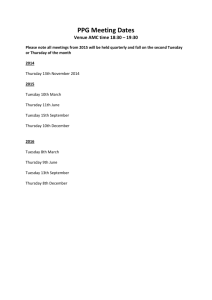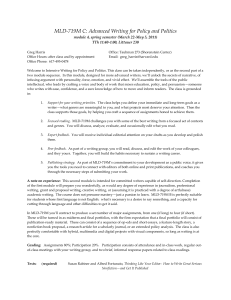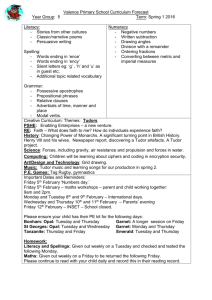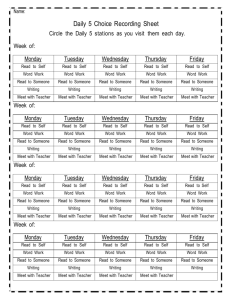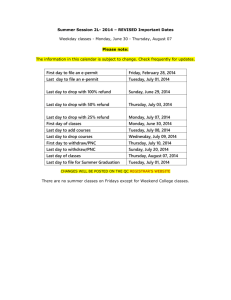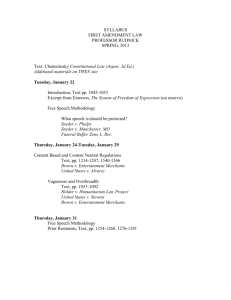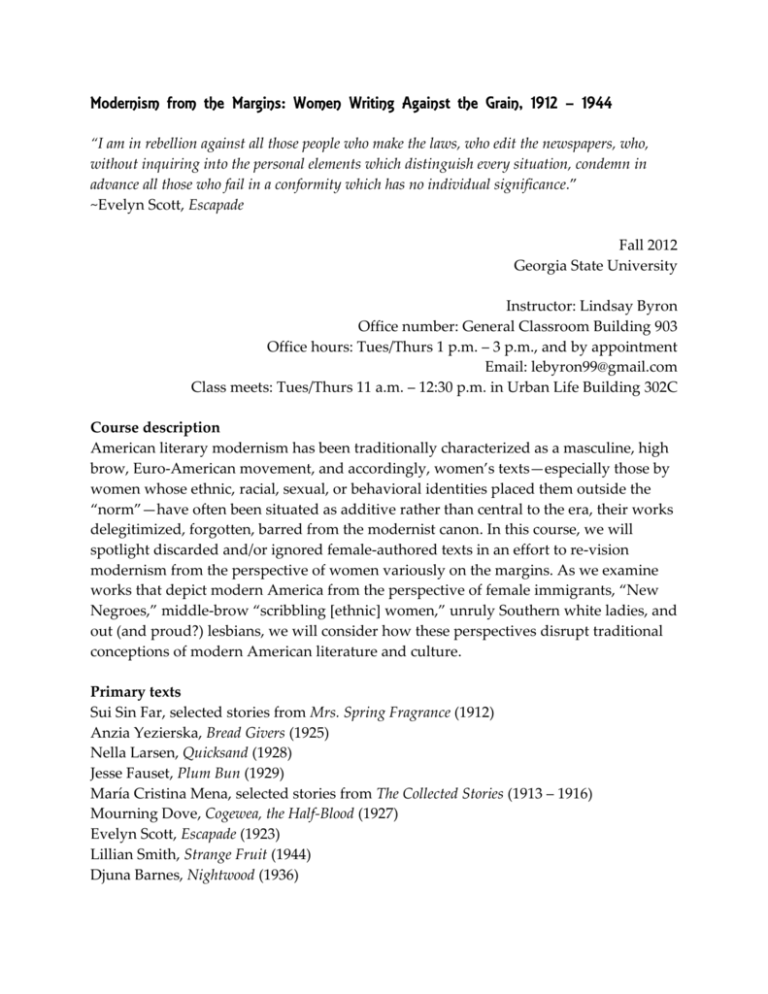
Modernism from the Margins: Women Writing Against the Grain, 1912 – 1944
“I am in rebellion against all those people who make the laws, who edit the newspapers, who,
without inquiring into the personal elements which distinguish every situation, condemn in
advance all those who fail in a conformity which has no individual significance.”
~Evelyn Scott, Escapade
Fall 2012
Georgia State University
Instructor: Lindsay Byron
Office number: General Classroom Building 903
Office hours: Tues/Thurs 1 p.m. – 3 p.m., and by appointment
Email: lebyron99@gmail.com
Class meets: Tues/Thurs 11 a.m. – 12:30 p.m. in Urban Life Building 302C
Course description
American literary modernism has been traditionally characterized as a masculine, high
brow, Euro-American movement, and accordingly, women’s texts—especially those by
women whose ethnic, racial, sexual, or behavioral identities placed them outside the
“norm”—have often been situated as additive rather than central to the era, their works
delegitimized, forgotten, barred from the modernist canon. In this course, we will
spotlight discarded and/or ignored female-authored texts in an effort to re-vision
modernism from the perspective of women variously on the margins. As we examine
works that depict modern America from the perspective of female immigrants, “New
Negroes,” middle-brow “scribbling [ethnic] women,” unruly Southern white ladies, and
out (and proud?) lesbians, we will consider how these perspectives disrupt traditional
conceptions of modern American literature and culture.
Primary texts
Sui Sin Far, selected stories from Mrs. Spring Fragrance (1912)
Anzia Yezierska, Bread Givers (1925)
Nella Larsen, Quicksand (1928)
Jesse Fauset, Plum Bun (1929)
María Cristina Mena, selected stories from The Collected Stories (1913 – 1916)
Mourning Dove, Cogewea, the Half-Blood (1927)
Evelyn Scott, Escapade (1923)
Lillian Smith, Strange Fruit (1944)
Djuna Barnes, Nightwood (1936)
Lillian Hellman, The Children’s Hour (1934)
Secondary texts have been collected in a course pack, available at Park Place Printing.
Requirements
Class participation and preparation--10%
Upper division literature classes are small in order to facilitate discussion. Therefore,
class participation is a crucial activity. Of course, discussions about reading can only be
meaningful when the participants have carefully read. This portion of the grade is
based on my assessment of the quality of your participation and preparation.
Papers--65%
Paper one, 25%:
undergraduates: a 5 -7 page close reading paper
Graduate students: an 8 – 10 page conference paper and presentation
Paper two, 40%:
undergraduates: an 8-10 page conference paper on a new topic or a 15 – 20 page
seminar paper expanding upon your close reading paper
graduate students: a 15- 20 page seminar paper, potentially (but not necessarily)
expanding upon your conference paper
“Discussion-starters”: 10%
There are twenty-eight classes this semester. You are required to submit two
“discussion starters” (provocative questions or comments about the reading) at the
beginning of twenty of these twenty-eight classes. Questions should demonstrate
thoughtful consideration of the text and an effort to engage classmates intellectually.
500 word response essays: 15%
I will occasionally assign short essays for homework written in response to class
discussion. Expect four to six of these short essay assignments, assigned as discussion
inspires.
-----------------------------------------------Daily Schedule-------------------------------------------------UNIT ONE—THEORETICAL AND HISTORICAL ORIENTATION
1. Censored, Delegitimized, Scandalized Women’s Writing
Tuesday, August 21
course introduction
Thursday, August 23
Provocative excerpts sampler: a collection of “scandalous” scenes from our major
authors’ works, as well as a selection of 1920s book reviews and newspaper
articles that discuss these scenes
2. New Modernist Frameworks
Tuesday, August 28
“Introduction,” Oxford Handbook of Modernisms
Thursday, August 30
Douglas and Rebecca Walkowitz. “The New Modernist Studies”
3. Historicizing the Texts
Tuesday, September 4:
Contemporary critical commentary sampler: a collection of excerpts from
newspapers, book reviews, pamphlets, and magazines that illustrate some of the
issues at the heart of our texts—such as immigration, assimilation, racial mixing,
sexual propriety, and the politics of representation
Thursday, September 6:
“Modernism in the Age of Mass Culture and Consumption,” Oxford Handbook of
Modernisms
UNIT TWO—IMMIGRANTS TO AMERICA
4. “Leaves from the Mental Portfolio of a Eurasian”
Tuesday, September 11
Primary texts: from Sui Sin Far’s Mrs. Spring Fragrance—"Leaves from the Mental
Portfolio of a Eurasian" (1909), "In the Land of the Free," "The Sing Song
Woman" (both 1912)
Secondary texts: “The Unwanted Immigrants: The Chinese” (1878)
Thursday, September 13:
Primary text: "Mrs. Spring Fragrance," "The Inferior Woman," "'Its Wavering
Image'" (all 1912)
Secondary texts: Emma Lazarus, “The New Colossus” (1883)
5. “The Sweatshop Cinderella”
Tuesday, September 18
Primary text: Anzia Yezierska’s Bread Givers (1925)
Secondary text: “A Girl who Came Up From Despair”(1923); Yosef Gaer, “Her
One Virtue” (1926)
Thursday, September 20
Primary text: Bread Givers, cont’d
Secondary Text: Yezierska, “This is What $10,000 Did To Me” (1925)
UNIT THREE—THE NEW NEGRO RENAISSANCE
6. “That inherent aloneness”: Straddling the Color Line
Tuesday, September 25
Primary text: Nella Larsen’s Quicksand (1928)
Secondary text: excerpt from “The Negro is Art: How Shall He Be Portrayed?”
(1926); Alain Locke, “1928: A Retrospective Review” (1929)
Thursday, September 27
Primary text: Quicksand, cont’d
Secondary texts: Langston Hughes, “The Negro Artist and the Racial Mountain”
(1926); Allison Davis, “Our Negro ‘Intellectuals’” (1928)
7. Passing into Class
Tuesday, October 2
Primary text: Jessie Fauset’s Plum Bun (1929)
Secondary texts: Louis Freemont Baldwin, “Negro to Caucasian, Or How the
Ethiopian is Changing His Skin” (1929); collected excerpts of news reports on the
Rhinelander case
Thursday, October 4
Primary text: Plum Bun, cont’d.
Secondary text: Martha Gruening, “The Negro Renaissance” (1932)
UNIT FOUR—MULTI-ETHNIC MIDDLEBROW
8. Colonialism, Immigration, and Stereotypes at the Mexican-American Border
Tuesday, October, 9
Primary text: Maria Cristina Mena, “The Gold Vanity Set” (1913), “The Education
of Popo” (1914), “The Vine Leaf” (1914)
Secondary text: Introduction to The Collected Works of Maria Cristina Mena (1997)
Thursday, October 11
Primary text: “The Birth of the God of War” (1914), “Marriage By Miracle” (1916 )
Secondary text: Clare Sheridan, “Contested Citizenship: National Identity and the
Mexican Immigration Debates of the 1920s” (2002)
PAPER ONE DUE
9. The Native/American “Half Blood”
Tuesday, October 16
Primary text: Mourning Dove’s Cogewea, the Half-Blood (1927)
Secondary text: Lisa Bothshon and Meredith Goldsmith, Introduction to
Middlebrow Moderns (2003)
Thursday, October 18
Primary text: Cogewea, the Half-Blood, cont’d.
Secondary text: Victoria Lamont, "Native American Oral Practice and the Popular
Novel; or, Why Mourning Dove Wrote a Western" (2005)
UNIT FIVE—SOUTHERN LADIES GONE WRONG
10. The Luxuries and Costs of Defiance
Tuesday, October 23
Primary text: Evelyn Scott’s Escapade(1923)
Secondary text: Dorothy Scura, Introduction to Evelyn Scott: Recovering a Lost
Modernist (2003)
Thursday, October 25
Escapade, cont’d.
Secondary text: Paula Snelling, “Evelyn Scott and Southern Background” (1937)
11. “Old Seeds Bearing a Heavy Crop”
Tuesday, October 30
Primary text: Lillian Smith’s Strange Fruit (1944)
Secondary text: Abel Meeropol, “Strange Fruit” (1936)
Thursday, November 1
Primary text: Strange Fruit, cont’d.
Secondary text: A Letter from Lillian Smith: "Old Seeds Bearing a Heavy Crop"
(1944)
UNIT SIX—OUT…AND PROUD?
12. “Loved by something strange”
Tuesday, November 6
Primary text: Djuna Barne’s Nightwood (1936)
Secondary text: Sherrie Inness, “Who’s Afraid of Stephen Gordon?: The Lesbian in
the United States Popular Imagination of the 1920s”
Thursday, November 8
Primary text: Nightwood, cont’d
Secondary text: Maurice Chideckel, MD. “Female Sex Perversion: The Sexually
Aberrated Woman As She Is” (1935)
13. “Murdering the Lesbian”
Tuesday, November 13
Primary text: Lillian Hellman’s play, The Children’s Hour (1934)
Secondary text: Mary Titus, “Murdering the Lesbian: Lillian Hellman's The
Children's Hour” (1991)
Thursday, November 15
Primary text: The Children’s Hour, cont’d
14. Thanksgiving Break
REFLECTIONS
15. Wrap-up
Tuesday, November 27
“Discussion-starters” round-table
Thursday, November 29
PAPER TWO DUE

